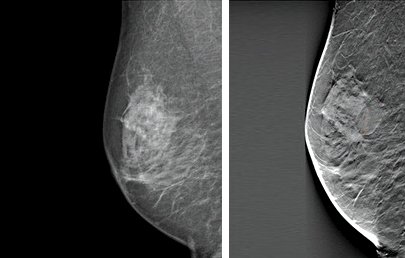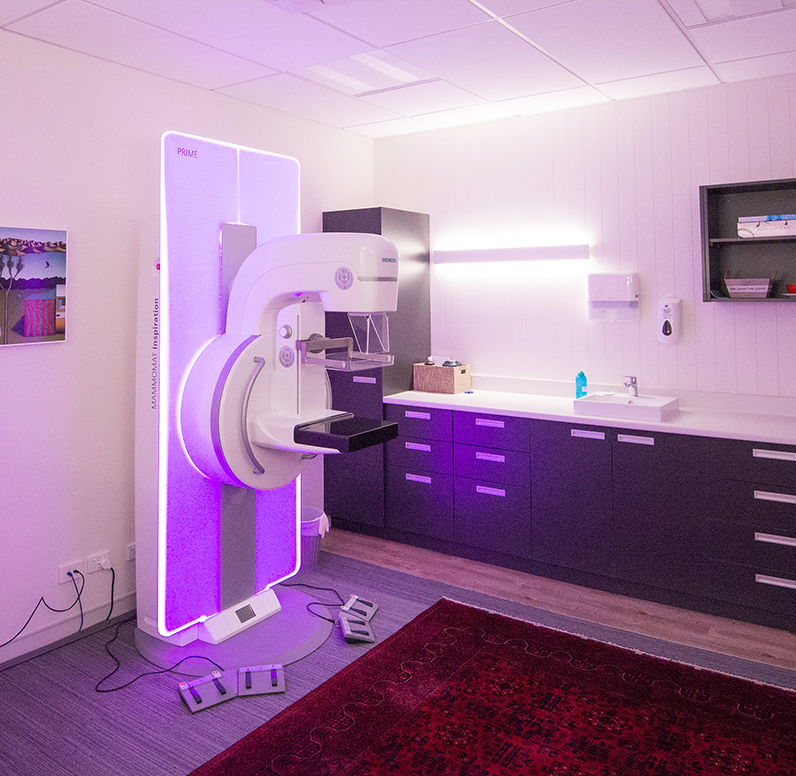3D breast tomosynthesis is an advanced breast cancer screening test that uses multiple low-dose X-ray images to create a 3D image of the breast.
A Three-dimensional (3D) mammogram, also known as breast tomosynthesis, is a type of digital mammography where X-ray machines take pictures of thin slices of the breast to produce a 3D image. This process results in a clearer, more detailed view of the breast tissue, making identifying and characterising abnormalities easier.
Tomosynthesis is similar to how a computed tomography (CT) scanner produces images of structures inside the body.

Cancer visible on the right 3D mammogram but not the left 2D mammogram.
In the mammogram image, the glandular and fibrous tissues are white, while the fat is black.
However, abnormalities that signal the presence of cancer also appear white and can be mistaken as normal glandular breast tissue, particularly if the breasts are dense.
A 3D tomosynthesis scan takes images, which the computer reconstructs into 1mm slices through the breast. Our specialist radiologist reads this in conjunction with state-of-the-art 2D digital images.
This scan improves cancer detection and reduces the number of unnecessary biopsies.

Our dose-reducing software ensures that the total radiation is not significantly different from previous imaging scans.
With new technology, our tomosynthesis system uses less compression and takes about 20 seconds longer to take the image than standard film mammography, designed with patient comfort in mind.
Please do not use deodorants, talcum powder or body lotions in the breast or underarm area on the day of your mammogram. You are welcome to bring them with you to apply after your examination.
Wearing a skirt or trousers is advisable as you must undress from the waist up. There will be a comfortable cape or gown available for you to wear.
Upon Arrival
Please remember to bring the referral note from your doctor.
We encourage you to bring any previous mammograms to your appointment; our radiologists need to have previous studies for comparison to look for any areas of change.
A skilled, qualified mammographer will take at least two images of each breast. Each breast is gently placed on the mammography machine and lightly compressed with a plastic paddle. This flattening of the breast reduces the breast thickness and holds it still, reducing the radiation dose and optimising the quality of the image.
Most women describe the compression as uncomfortable rather than painful. If you find the compression painful, please discuss your concerns with the mammographer, who will try to eliminate any distress.
Sometimes, further mammograms are needed to show an area of the breast more clearly. Don't be overly concerned if this occurs. An ultrasound scan may also be necessary to complete your examination.
After we take the images, we will ask you to wait until the mammographer has viewed them to see if any more are needed. At least two radiologists will then read your images independently before we send a report to your referring doctor.
A small number of women will need further investigations after a mammogram with additional mammography or a breast ultrasound. We will be in contact if you require further imaging.
3D tomosynthesis differs from traditional mammography as it captures additional X-ray images from various angles. While 2D mammograms boast a commendable cancer detection rate, 3D mammography is especially beneficial for patients with denser breast tissues and has proven to detect more breast cancers and minimise false-positive results.
3D tomosynthesis gives radiologists a clearer, more detailed perspective of breast tissue. The technology makes identifying and characterising abnormalities that may indicate cancer, such as masses and microcalcifications, easier.
While 2D mammograms are effective in detecting cancer, it's important to note that a smaller percentage of cancers may only be visible on 3D mammograms, particularly in individuals with higher breast densities. The integration of tomosynthesis with 2D mammography has reduced the need for follow-up imaging, providing a more detailed and accurate view of the breast, leading to fewer false alarms and unnecessary tests.